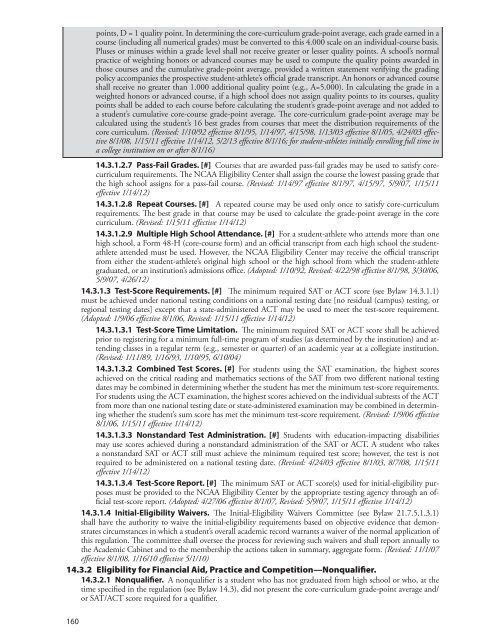ncaa-manual
ncaa-manual
ncaa-manual
- No tags were found...
Create successful ePaper yourself
Turn your PDF publications into a flip-book with our unique Google optimized e-Paper software.
160points, D = 1 quality point. In determining the core-curriculum grade-point average, each grade earned in acourse (including all numerical grades) must be converted to this 4.000 scale on an individual-course basis.Pluses or minuses within a grade level shall not receive greater or lesser quality points. A school’s normalpractice of weighting honors or advanced courses may be used to compute the quality points awarded inthose courses and the cumulative grade-point average, provided a written statement verifying the gradingpolicy accompanies the prospective student-athlete’s official grade transcript. An honors or advanced courseshall receive no greater than 1.000 additional quality point (e.g., A=5.000). In calculating the grade in aweighted honors or advanced course, if a high school does not assign quality points to its courses, qualitypoints shall be added to each course before calculating the student’s grade-point average and not added toa student’s cumulative core-course grade-point average. The core-curriculum grade-point average may becalculated using the student’s 16 best grades from courses that meet the distribution requirements of thecore curriculum. (Revised: 1/10/92 effective 8/1/95, 1/14/97, 4/15/98, 1/13/03 effective 8/1/05, 4/24/03 effective8/1/08, 1/15/11 effective 1/14/12, 5/2/13 effective 8/1/16; for student-athletes initially enrolling full time ina college institution on or after 8/1/16)14.3.1.2.7 Pass-Fail Grades. [#] Courses that are awarded pass-fail grades may be used to satisfy corecurriculumrequirements. The NCAA Eligibility Center shall assign the course the lowest passing grade thatthe high school assigns for a pass-fail course. (Revised: 1/14/97 effective 8/1/97, 4/15/97, 5/9/07, 1/15/11effective 1/14/12)14.3.1.2.8 Repeat Courses. [#] A repeated course may be used only once to satisfy core-curriculumrequirements. The best grade in that course may be used to calculate the grade-point average in the corecurriculum. (Revised: 1/15/11 effective 1/14/12)14.3.1.2.9 Multiple High School Attendance. [#] For a student-athlete who attends more than onehigh school, a Form 48-H (core-course form) and an official transcript from each high school the studentathleteattended must be used. However, the NCAA Eligibility Center may receive the official transcriptfrom either the student-athlete’s original high school or the high school from which the student-athletegraduated, or an institution’s admissions office. (Adopted: 1/10/92, Revised: 4/22/98 effective 8/1/98, 3/30/06,5/9/07, 4/26/12)14.3.1.3 Test-Score Requirements. [#] The minimum required SAT or ACT score (see Bylaw 14.3.1.1)must be achieved under national testing conditions on a national testing date [no residual (campus) testing, orregional testing dates] except that a state-administered ACT may be used to meet the test-score requirement.(Adopted: 1/9/06 effective 8/1/06, Revised: 1/15/11 effective 1/14/12)14.3.1.3.1 Test-Score Time Limitation. The minimum required SAT or ACT score shall be achievedprior to registering for a minimum full-time program of studies (as determined by the institution) and attendingclasses in a regular term (e.g., semester or quarter) of an academic year at a collegiate institution.(Revised: 1/11/89, 1/16/93, 1/10/95, 6/10/04)14.3.1.3.2 Combined Test Scores. [#] For students using the SAT examination, the highest scoresachieved on the critical reading and mathematics sections of the SAT from two different national testingdates may be combined in determining whether the student has met the minimum test-score requirements.For students using the ACT examination, the highest scores achieved on the individual subtests of the ACTfrom more than one national testing date or state-administered examination may be combined in determiningwhether the student’s sum score has met the minimum test-score requirement. (Revised: 1/9/06 effective8/1/06, 1/15/11 effective 1/14/12)14.3.1.3.3 Nonstandard Test Administration. [#] Students with education-impacting disabilitiesmay use scores achieved during a nonstandard administration of the SAT or ACT. A student who takesa nonstandard SAT or ACT still must achieve the minimum required test score; however, the test is notrequired to be administered on a national testing date. (Revised: 4/24/03 effective 8/1/03, 8/7/08, 1/15/11effective 1/14/12)14.3.1.3.4 Test-Score Report. [#] The minimum SAT or ACT score(s) used for initial-eligibility purposesmust be provided to the NCAA Eligibility Center by the appropriate testing agency through an officialtest-score report. (Adopted: 4/27/06 effective 8/1/07, Revised: 5/9/07, 1/15/11 effective 1/14/12)14.3.1.4 Initial-Eligibility Waivers. The Initial-Eligibility Waivers Committee (see Bylaw 21.7.5.1.3.1)shall have the authority to waive the initial-eligibility requirements based on objective evidence that demonstratescircumstances in which a student’s overall academic record warrants a waiver of the normal application ofthis regulation. The committee shall oversee the process for reviewing such waivers and shall report annually tothe Academic Cabinet and to the membership the actions taken in summary, aggregate form. (Revised: 11/1/07effective 8/1/08, 1/16/10 effective 5/1/10)14.3.2 Eligibility for Financial Aid, Practice and Competition—Nonqualifier.14.3.2.1 Nonqualifier. A nonqualifier is a student who has not graduated from high school or who, at thetime specified in the regulation (see Bylaw 14.3), did not present the core-curriculum grade-point average and/or SAT/ACT score required for a qualifier.


